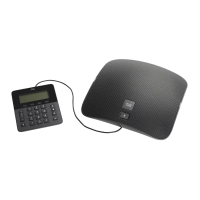Cisco Catalyst Switch or other third-party switch
The switch must support 802.1X, so it can act as the authenticator and pass the messages between the
phone and the authentication server. After the exchange completes, the switch grants or denies the
phone access to the network.
Best practices
The following list describes best practices for 802.1X configuration.
•
Enable 802.1X Authentication: If you want to use the 802.1X standard to authenticate Cisco Unified IP
Phones, be sure that you properly configure the other components before enabling it on the phone.
•
Configure Voice VLAN: Because the 802.1X standard does not account for VLANs, you should configure
this setting based on the switch support.
◦
Enabled: If you are using a switch that supports multi-domain authentication, you can continue to
use the voice VLAN.
◦
Disabled: If the switch does not support multi-domain authentication, disable the Voice VLAN
and consider assigning the port to the native VLAN.
•
Enter MD5 Shared Secret: If you disable 802.1X authentication or perform a factory reset on the phone,
the previously configured MD5 shared secret is deleted.
Security restrictions
A user cannot barge into an encrypted call if the phone that is used to barge is not configured for encryption.
In this case, a reorder (fast busy) tone plays on the phone from which the barge was initiated.
If the initiator phone is configured for encryption, the barge initiator can barge into a nonsecure call from the
encrypted phone. After the barge occurs, Cisco Unified Communications Manager classifies the call as
nonsecure.
If the initiator phone is configured for encryption, the barge initiator can barge into an encrypted call, and the
phone indicates that the call is encrypted.
Cisco Unified IP Conference Phone 8831 deployment
When deploying a new IP telephony system, system administrators and network administrators must complete
several initial configuration tasks to prepare the network for IP telephony service. For information and a
checklist for setting up and configuring a complete Cisco IP telephony network, see the “System Configuration
Overview” chapter in the Cisco Unified Communications Manager System Guide.
After the IP telephony system is setup and you have configured system-wide features in Cisco Unified
Communications Manager, phones can be added to the system.
For an overview of procedures used to add phones to your network, see the “Installation” and “Setup in Cisco
Unified Communications Manager” sections of this guide.
Cisco Unified IP Conference Phone 8831 Administration Guide for Cisco Unified Communications Manager
9.0
28
Cisco Unified IP Conference Phone 8831
Security restrictions

